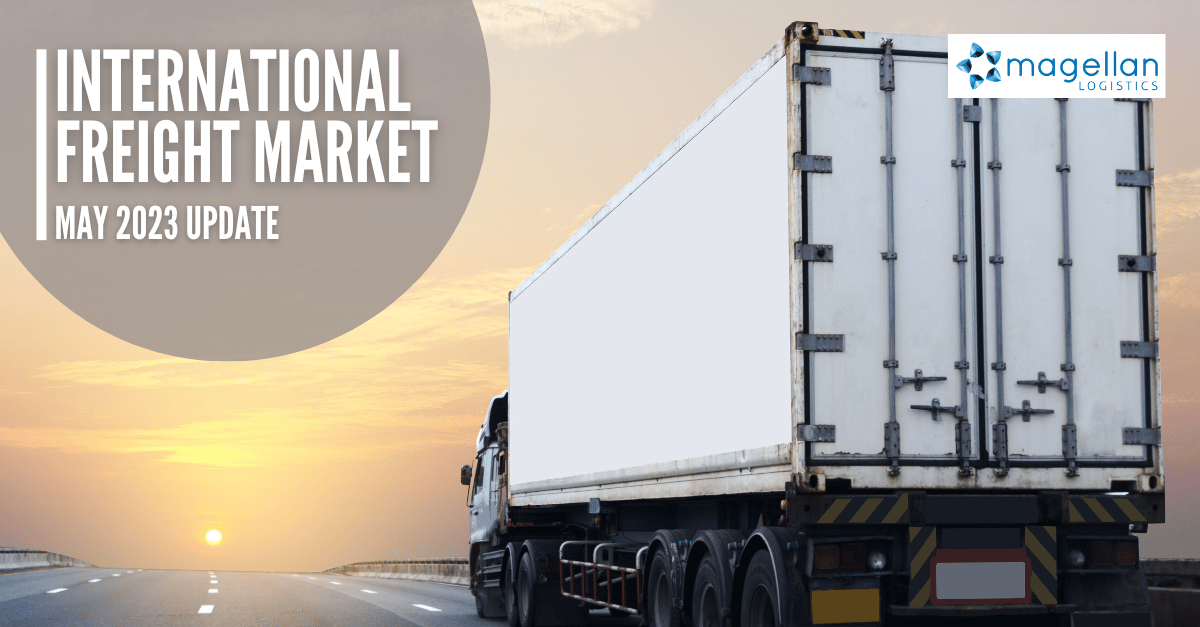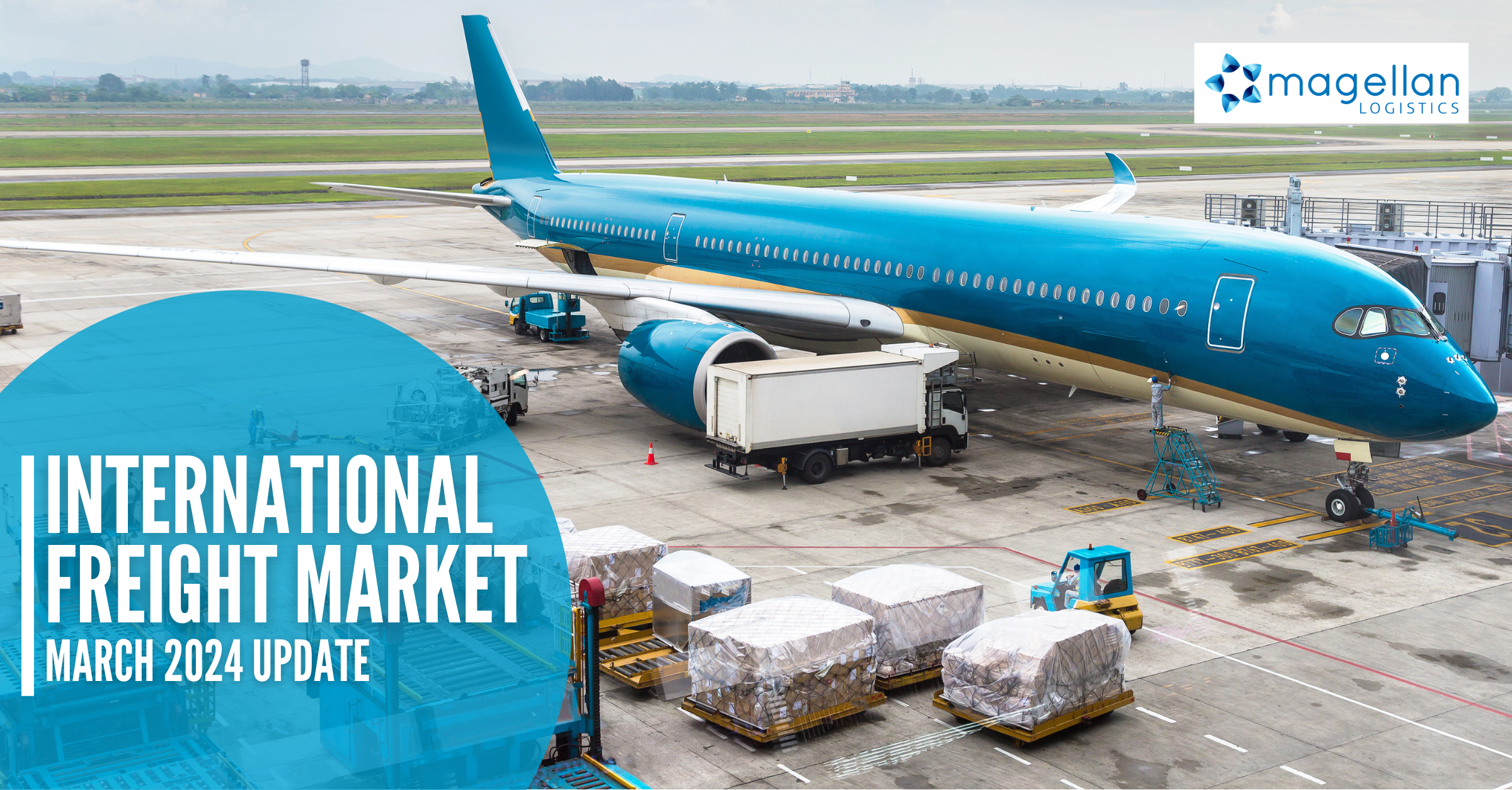In this international freight market update, economic tightening and a reduction in trade volumes continue as a key drivers of market conditions. High inflation and the burden of the monetary policy designed to manage it has seen most Australian households feel the pinch. The slowdown in consumer demand is driving reduced demand for space in most global markets as importers review their inventories and order books.
Freight market update
- Import freight rates from China are still low, with some carriers yet to increase.
- Rate restoration charges are being announced for some trade lanes to maintain services.
- There was a 1% decline in total sailings in March – another signal of decreasing global demand.
- Global sea freight schedule reliability increased to 60.2% in February 2023, a year-on-year increase of 26%. Improvement can be attributed to eased congestion and better port conditions. Reliability now aligns with August 2020, when it began to decline notably amid the COVID-19 pandemic.
- Global average vessel delays continued to decrease, now at 5.29 days, two days lower than February 2022 (7.59 days)
- Shipping analysts at HSBC have called the bottom of the cycle for container shipping, with the latest freight market report making the case that the sector is now on the way back up. HSBC argued that spot rates have likely troughed, and a recovery is now on the cards.
A ‘green’ wave
- Carriers are investing heavily in methanol-ready vessels. Cosco added an order of 4 x 16000 teu ships, all methanol capable, and Maersk unveiled designs of their first green fuel-powered vessel operating on green methanol.
- Carriers investing in methanol plants and Singapore (as the world’s top bunkering hub) are getting the infrastructure in place to cater for higher Methanol activity due to carrier efforts and investments to go green.
- IMO regulations introduced in January 2023 made it compulsory for all ships to calculate their Energy Efficiency Existing Ship Index (EEXI) and collect data to report their annual operational carbon intensity indicator (CII). Since then, carriers have begun to reduce vessel speed and increase transit times to meet the current requirements.
- From 2024 the EU will enforce carbon taxes on shipping lines carrying goods to and from Europe. This means shipping lines must consider alternative fuel sources or accept the taxes to continue with current fuels. If shipping lines accept the taxes, it will lead to a minimum 35% price increase. LNG and other alternative fuels are not yet readily available in commercial volumes, and, according to Drewry, a change to a fuel source like LNG could raise costs by up to 340%.
Asia to Asia Pacific
Volume is slowly recovering after holidays in different major exporting Southeast Asia countries, and carriers are reporting 80-90% utilisation. Rates are stabilising, and carriers continue with structural blank sailings for some services. Advance bookings are strongly recommended for time-sensitive shipments, ideally on direct service.
China / North Asia
No GRI has been announced, and there is no indication of one before the end of June. However, securing space is not difficult as there is still plenty of capacity. Carriers are responding to the weak market performance with regular blank sailing or rescheduling of sailings.
The airfreight market has been in a steady state since late March. Rates are slowly improving, with limited demand still acting as a brake on increases.
South East Asia
Airfreight remains steady, with some slight increases in rates and space limitations. No GRI has been announced, and conditions are slow. No blank sailing plan has been announced, and we expect rates to remain relatively stable.
India
Terminal operators in Nhava Sheva have announced a price increase due to commence later in May. The Container Shipping Lines Association (CSLA) have argued the increases are “unjustifiable” given the current congested port situation and reduced capacity.
North America
- GRIs from West Coast USA to AU/NZ and New Caledonia have been announced and are effective from 5 June.
- The Pacific Maritime Association (PMA) reports extensive delays at Long Beach and Los Angeles due to industrial disputes.
- The level of trade entering the country is not showing a consistent pattern. However, US exports are showing a modest but positive increase since January.
- Another persistent challenge in the US is the ongoing chassis shortages, which result in pickup and delivery delays.
- There is additional space in the airfreight market due to weak demand.
Europe and UK
The market is steady, with no blank sailings announced. Space is plentiful, rates are stable, and no price increases are expected in the short term.
Pakistan
Orders are on the rise for larger exporters. However, inflation in the US and EU impacts small to medium exporters.
Blank sailings have commenced. Shipping lines may push for a rate increase in May, but no GRI announcement has been made.
Airfreight pricing is flat, and space is available.
Bangladesh
No blank sailings are expected. Equipment is also available, and no GRIs are scheduled in the short term.
Factories continued loading cargo in the EID lead-up, with some space pressure due to large cargo arrivals. Airfreight is expected to settle soon.
Australia ports
Container volume (TEUs) in February was down 19% across the four major ports comprising Botany down 26%, Melbourne down 20%, Fremantle down 17%, and Brisbane down 8%. February’s result was the most significant monthly decline recorded in at least the last 20 years across the four ports. It was the fourth consecutive month of declines (Nov -3%, Dec -8%, Jan -4%)
Hutchison Ports have provided a notice of intention to increase landside charges effective 22 May 2023 at their Brisbane and Sydney stevedore operations.
VICT (Melbourne) has provided a notice of intention to increase landside and infrastructure charges. Effective 1 June 2023, they will introduce VGM Weight Discrepancy & Reefer Temp Discrepancy Fees, and effective 1 July, an increase to Infrastructure Surcharge.
Patrick Terminals
- Brisbane: Working with minimal delays of approximately 0.5 day
- Fremantle: Working with minimal delays of approximately 0.5 day
- Sydney: Working with minimal delays of approximately one day
DP World Terminals
- Brisbane: Working with avg. delay of 0.5 day
- Fremantle: Working with minimal delays of approximately two days
- Sydney: Working with an average delay of 1 day
- Melbourne: Working with an average delay of 0.5 day
VICT
- Melbourne: Working with an average delay of 1-2 days
NZ Ports
- NZ Ports – It is expected other major ports across NZ will soon adopt fixed berthing windows, increasing service reliability for shipping lines and their customers.
Economic outlook
Europe:
After a contraction at the end of 2022, Europe is expected to experience slight growth in 2023 of 0.8% and gradually improve to 1.1% in 2024 and 1.8% in 2025. High inflation continues to compromise household purchasing power, and strict financial conditions restrain investment. However, ongoing banking stresses, persistent core inflation, escalation of the conflict in Ukraine, and more severe and widespread downturns in house markets may present a risk of recession.
Americas:
US economic growth is slowing as credit tightens. The employment, income and household wealth improvements that drove growth in consumer spending at the start of this year are fading, with only sluggish growth expected in the second half of 2023. The unemployment rate is projected to rise from 3.5% in March to 4.6% by 2025. High-interest rates and more restrictive lending conditions will lead to declines across the construction sector.
Asia Pacific:
Led by solid growth in China and India, Asia-Pacific’s GDP is expected to pick up from 3.2% last year to 4.1% in 2023 and 4.6% in 2024, accounting for about 60% of global growth.
Mainland China’s economy is rebounding after the end of zero-COVID policies, most sharply in the hospitality and transportation sectors hit hardest by pandemic controls. Weak export markets are constraining growth in manufacturing. Housing prices, sales and construction completions have all recovered, but new housing construction has declined.
The Japanese economy shows a wider divergence between manufacturing and services activity. Weaker-than-expected external demand is the primary reason behind a drop in GDP. Export volumes rebounded by 3.5% month-on-month in Feb, but net exports declined in Q1. A decrease in exports has outpaced the decline in import volume.
Magellan Logistics provides freight and logistics services to all industries, including sea freight, air freight, customs clearance and the all-important digital freight portal providing 24/7 visibility of all your shipments. Keeping customers abreast of changing market conditions is critical in what we do. Our dedicated and professional team would love an opportunity to assist your business. If you have questions about the Freight Market Update, please get in touch on 1300 651 888.
Sources:
With thanks to the FTA for their Market Update













